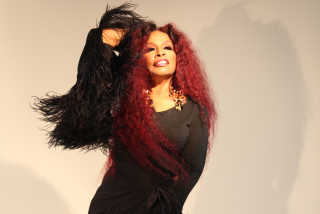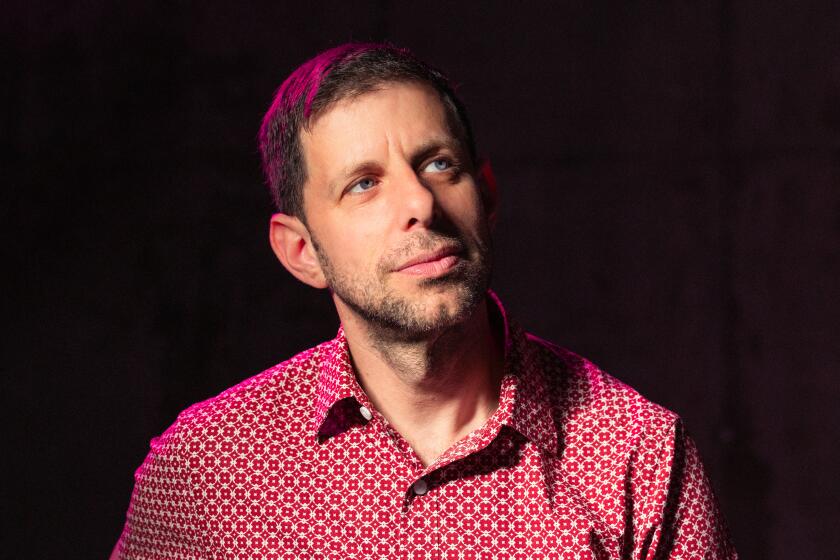The future looks a lot like local time
Border crossings dominated Jamie Nichols’ Celebrate Dance 2008 at the Alex Theatre on Saturday, the latest installment in an annual showcase of mostly local choreographers and companies. No matter how the eight pieces began -- whatever vocabularies or idioms represented home base -- you could predict that they’d soon head into uncharted territory.
Some works used virtuosity to keep you watching. They were experiments disguised as showpieces. Others simply assumed that the audience craved exploration, wherever it led.
The easiest to describe is the oldest: Marie de la Palme’s familiar “Le Coeur Illumine” (to Ravel) from 1999. Fusing balletic pointe technique with gymnastics, it showed Melissa Sandvig unwinding from one long skein of crimson fabric only to embrace and climb another, stretching and spinning high above the stage.
Lyrical, dreamlike, metaphoric, the solo provided balm to the eyes even as it tested the dancer’s upper body strength as few ballerina vehicles ever have.
Bradley Michaud’s “Claudia” (done to remixed Orbital), one of the six premieres on the program, turned hyper-physical, take-no-prisoners movement inside out, using it for confessional psychodrama. Harrowing solos for Michaud, Nicole Cox and Jessica Harper, plus a more conventional (and less satisfying) final trio, became expressions of pain -- raw evidence of how people can be torn apart by their emotions.
We’re used to this kind of subject in conventional modern dance, but not with the kind of fearless athlete-dancers usually intent on displaying limitless prowess.
A similar mission made Bay Area choreographer Viktor Kabaniaev stray far from the Russian classicism of his heritage toward ultimate stylistic transparency in the complex solo “Episodes of . . . ,” to an original score by Kabaniaev and Nicolas Van Krijdt.
As Irene Liu moved from liquid horizontal passages into edgier, more assaultive sections, the whole question of techniques and training systems dissolved.
Ultimately, you knew only that Kabaniaev had in his creative arsenal everything he needed to tell this story about a woman’s deepest feelings.
With his brilliant quintet “Metanoia,” Jacob “Kujo” Lyons took his radically reconceptualized street-dance style into the realm of the spiritual, slowing down B-boy maneuvers and gymnastics until they became a perfect if unlikely complement to Arvo Part’s agonized “Credo.”
At one point, Lyons choreographed a trio that amplified the cantilevered balances he was exploring at that moment in a duet with Sarah Moser, a sequence as daring structurally as it was physically -- and drop-dead awesome in its millennial bravura.
In their unsparing male sextet “Dar Es Salaam,” Esther Baker-Tarpaga and Olivier Tarpaga used exotic music (mostly live) and a forceful, individual brand of movement theater to depict the unbearably brutal physical labor, individual suffering and moments of brotherly solidarity of a lifestyle scarcely ever evoked on dance stages.
We never learned who these workers were (miners? factory hands? convicts?), but their intensity proved unforgettable.
Lillian Barbeito’s “Da Vinder,” set to a compendium of contemporary recordings accented and overlaid with live cello, took four women in the opposite direction: from restless searching to acceptance and affirmation.
Fresh and skillful, it ended with a solo with nothing in mind other than Tina Finkelman Berkett’s playful and almost childlike interaction with cellist Emily Corwin. And that was more than enough.
Looking backdated among the evening’s more ambitious offerings, Ana Maria Alvarez’s spirited “Mundo Plastico” (mostly to Willie Colon and Rubin Blades) subjected Latino ballroom dancing to rudimentary analysis via slow-motion and other structural strategies -- though the final sequence kept her cast clustered upstage for too long to make much impact.
And Jennifer Backhaus’ fluid octet “Arrive” (performed to Mogwai and Explosions in the Sky) simply reiterated what the local dance community already knew about her sophistication and refinement without asking her excellent dancers for anything they hadn’t done before. Nice work, but a mite disappointing in an evening focused on the future of the art.
--
More to Read
The biggest entertainment stories
Get our big stories about Hollywood, film, television, music, arts, culture and more right in your inbox as soon as they publish.
You may occasionally receive promotional content from the Los Angeles Times.






